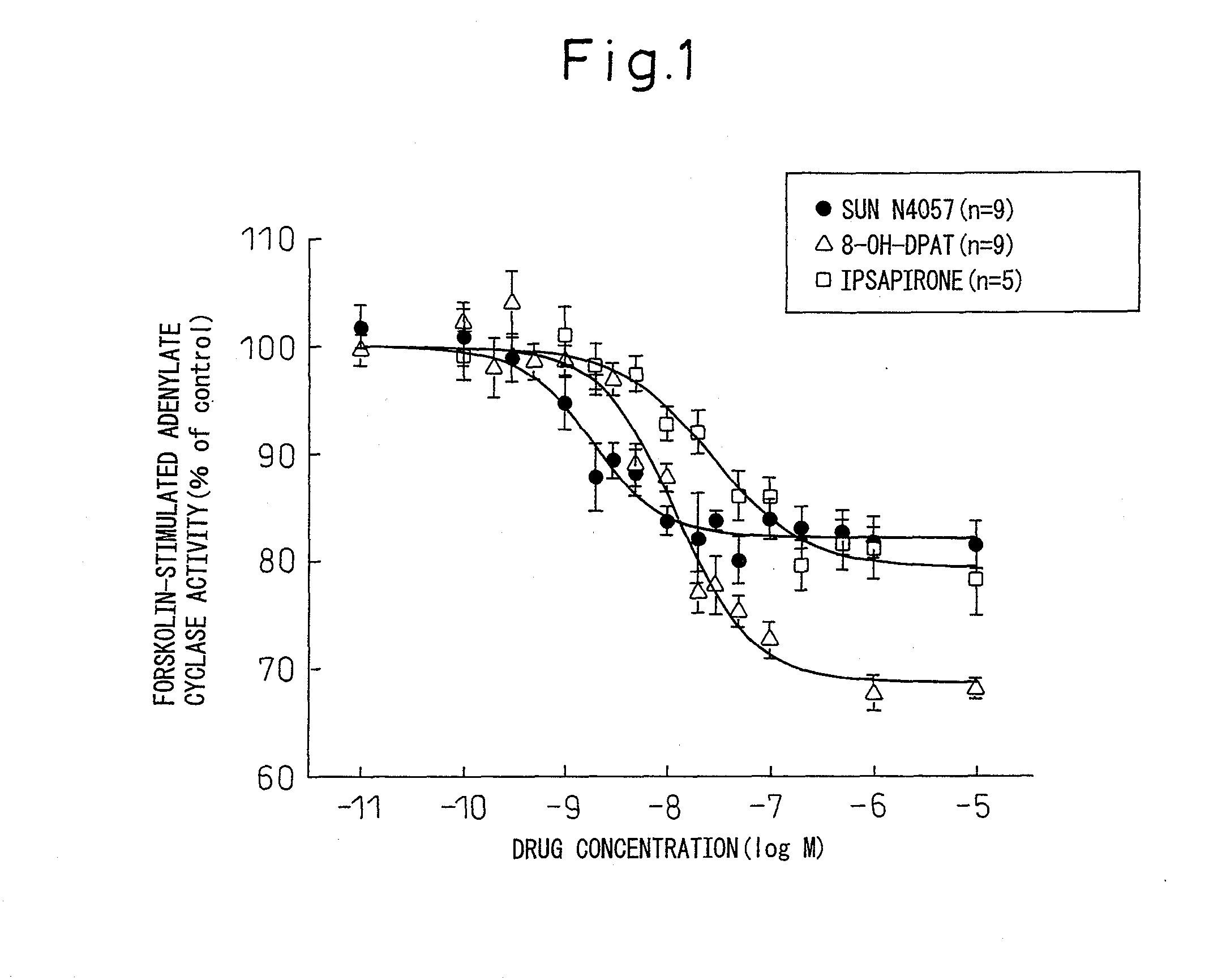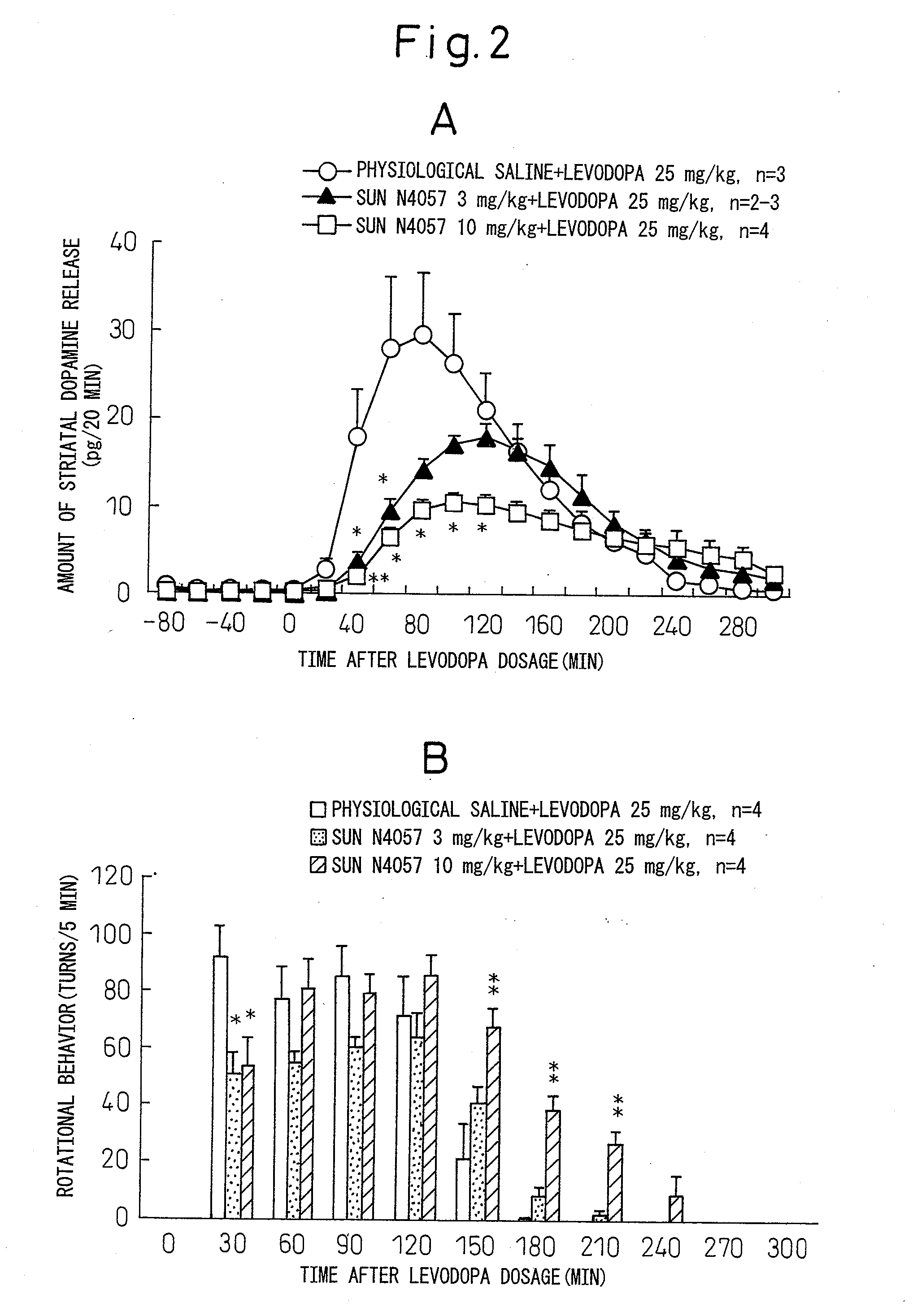Drug for alleviating motor complications or psychiatric symptoms of parkinson's disease
a technology for psychiatric symptoms and parkinson's disease, which is applied in the direction of biocide, drug composition, organic chemistry, etc., can solve the problems of difficult treatment, recovery cannot be expected, and it is difficult to obtain a sufficient therapeutic effect only with a dopamine d2 receptor agonist, so as to delay the progression of symptoms
- Summary
- Abstract
- Description
- Claims
- Application Information
AI Technical Summary
Benefits of technology
Problems solved by technology
Method used
Image
Examples
example 1
Binding Affinity Tests on Human Serotonin 1A Receptors, Human Dopamine D2L Receptors, Human Dopamine D2S Receptors and Human Dopamine D3 Receptors
[0099]1-1. Binding Affinity Test an Human Serotonin 1A Receptors
[0100]For the test, membrane specimens prepared from Chinese hamster ovary (CHO-K1) cells expressing human serotonin 1A receptors were used. To a 50 mM Tris-HCl buffer (pH 7.4) including 5 mM CaCl2, 0.1% ascorbic acid, and 10 μg / mL saponin, [3H] 8-hydroxy-2-(di-n-propylamino)tetraline ([3H]8-OH-DPAT) (final concentration 1 nM), the test sample solution and the membrane specimen were added. The reaction solution was allowed to react at 25° C. for 60 minutes, then the reaction solution was filtered with a cell harvester, the filtered filter paper was transferred to a measurement vial, a liquid scintillator was added and the receptor bond radioactivity remaining on the filter paper was determined by a liquid scintillation counter. The nonspecific bonds were defined as the amount ...
example 2
Study of Agonist / Antagonist Activity for Human Serotonin 1A Receptors, Human Dopamine D2L Receptors, Human Dopamine D2S Receptors, and Human Dopamine D3 Receptors
[0118]For the tests, membrane specimens prepared from Chinese hamster ovary (CHO-K1) cells expressing human serotonin 1A receptors, Chinese hamster ovary (CHO) cells expressing human dopamine D2L receptors, Chinese hamster ovary (CHO) cells expressing human dopamine D2S receptors and Chinese hamster ovary (CHO) cells expressing human dopamine D3 receptors were used. In the agonist assays, for the serotonin 1A receptors, [35S] GTPγS (final concentration 0.1 nM), a GDP solution (final concentration 3 μM), the test sample solution and a membrane specimen were added to a 20 mM Hepes-NaOH buffer (pH 7.4) containing 100 mM NaCl, 3 mM MgCl2 and 10 μg / mL saponin and allowed to react at 25° C. for 30 minutes. Further, for the dopamine (D2L, D2S and D3) receptors, [35S] GTPγS (i.e., final concentration 0.1 nM), a GDP solution (final ...
example 3
Adenylate Cyclase Inhibition Test Via Rat Serotonin 1A Receptors (Full Agonist-Partial Agonist Judgment Test)
[0121]In Example 3, 8-OH-DPAT and {2-[4-(4-pyrimidin-2-ylpiperidin-1-yl)butyl]-1,2-benzothiazole-3(2H)-one 1,1-deoxide} (hereinafter referred to as “ipsapirone”) were used for comparison. 8-OH-DPAT is well known as a typical serotonin 1A receptor full agonist, while ipsapirone is well known as a typical serotonin 1A receptor partial agonist.
[0122]For the test, Wistar male rats supplied by Shimizu Laboratory Supplies were used (9 to 15 weeks old). Each rat was decapitated and the hippocampus was quickly removed. It was homogenized in 10 volumes of buffer (i.e., 25 mM Tris-HCl, 1 mM EGTA, 5 mM EDTA, 5 mM DTT, 300 mM sucrose, 100 KIU / ml aprotinin, pH 7.4). This was then centrifuged at 500×g, 4° C. for 5 minutes, the supernatant was further centrifuged at 39,000×g, 4° C. for 10 minutes, and the residue was used as the rat hippocampus membrane specimen. The rat hippocampus membran...
PUM
| Property | Measurement | Unit |
|---|---|---|
| Current | aaaaa | aaaaa |
| Time | aaaaa | aaaaa |
Abstract
Description
Claims
Application Information
 Login to View More
Login to View More - R&D Engineer
- R&D Manager
- IP Professional
- Industry Leading Data Capabilities
- Powerful AI technology
- Patent DNA Extraction
Browse by: Latest US Patents, China's latest patents, Technical Efficacy Thesaurus, Application Domain, Technology Topic, Popular Technical Reports.
© 2024 PatSnap. All rights reserved.Legal|Privacy policy|Modern Slavery Act Transparency Statement|Sitemap|About US| Contact US: help@patsnap.com










